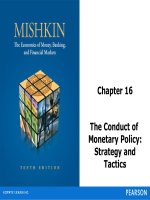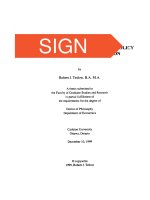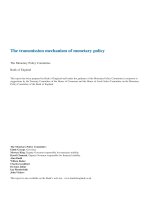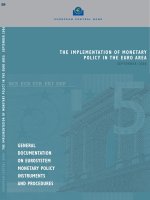Transmission mechanisms of monetary policy the evidence
Bạn đang xem bản rút gọn của tài liệu. Xem và tải ngay bản đầy đủ của tài liệu tại đây (309.64 KB, 25 trang )
Chapter 25
Transmission Mechanisms of
Monetary Policy: The Evidence
Structural Model
• Examines whether one variable affects another by
using data to build a model that explains the
channels through which the variable affects the
other
• Transmission mechanism
– The change in the money supply affects interest rates
– Interest rates affect investment spending
– Investment spending is a component of aggregate
spending (output)
Reduced-Form
• Examines whether one variable has an effect
on another by looking directly at the
relationship between the two
• Analyzes the effect of changes in money supply
on aggregate output (spending) to see if there
is a high correlation
• Does not describe the specific path
Structural Model
Advantages and Disadvantages
• Possible to gather more evidence ⇒ more
confidence on the direction of causation
• More accurate predictions
• Understand how institutional changes affect
the links
• Only as good as the model it is based on
Advantages and Disadvantages of
Reduced Form Evidence
• No restrictions imposed on the way monetary
policy affects the economy
• Correlation does not necessarily
imply causation
– Reverse causation
– Outside driving factor
Early Keynesian Evidence on the
Importance of Money
• Monetary policy does not matter at all
• Three pieces of structural model evidence
– Low interest rates during the Great Depression indicated
expansionary monetary policy but had no effect on the
economy
– Empirical studies found no linkage between movement in
nominal interest rates and investment spending
– Surveys of business people confirmed that investment in
physical capital was not based on market interest rates
Objections to
Early Keynesian Evidence
• Friedman and Schwartz published a monetary history
of the U.S. showing that monetary policy was actually
contractionary during the Great Depression
• Many different interest rates
• During deflation, low nominal interest rates do not
necessarily indicate expansionary policy
• Weak link between nominal interest rates and
investment spending does not rule out a strong link
between real interest rates and investment spending
• Interest-rate effects are only one of many channels
Real and Nominal Interest Rates (T-bills)
1931-2009
Early Monetarist Evidence on the
Importance of Money
• Money growth causes business cycle fluctuations but
its effect on the business cycle operates with “long
and variable lags”
• Post hoc, ergo propter hoc
– Exogenous event
– Reduced form nature leads to possibility of
reverse causation
– Lag may be a lead
Hypothetical Example in Which Money Growth
Leads Output
Statistical Evidence
• Autonomous expenditure variable equal
to investment spending plus government spending
– For Keynesian model AE should be highly correlated with
aggregate spending but money supply should not
– For Monetarist money supply should be highly correlated
with aggregate spending but AE
should not
• Neither model has turned out be more accurate than
the other
Historical Evidence
• If the decline in the growth rate of the money supply
is soon followed by a decline in output in these
episodes, much stronger evidence is presented that
money growth is the driving force behind the business
cycle
• A Monetary History documents several instances in
which the change in the money supply is an
exogenous event and the change in the business cycle
soon followed
Transmission Mechanisms of Monetary
Policy
Traditional Interest-Rate Channels:
expansionary monetary policy
ir ↓, I ↑, Y↑
The interest rate channel of monetary transmission
applies equally to C. Also, it places emphasis on ir rather
than i. Moreover, it is the long-term ir and not the shortterm ir that is viewed as having the major impact on C and
I spending
expansionary monetary policy
Pe ↑, πe ↑, ir ↓, C and I ↑, Y ↑
Exchange Rate Channel
expansionary monetary policy
ir ↓, E ↓, NX ↑, Y ↑
When ir ↓ the domestic currency depreciates,
that is E ↓. This makes domestic goods relatively
less expensive and NX ↑.
Recent work indicates that the exchange rate
transmission mechanism plays an important role
in how monetary policy affects the economy
Tobin’s q
Tobin’s q Channel:
q=
MVF
RCC
In this case, companies can issue stock and get a high price
for it relative to the cost of the facilities and equipment they
are buying. I ↑ because firms can buy a lot of new investment
goods with only a small issue of stock.
The transmission mechanism for monetary policy is
expansionary monetary policy Pe ↑, q ↑, I ↑, Y ↑
where Pe is the price of equity (not the expected price level)
Wealth Channel
Expansionary monetary policy ↑ stock prices, the wealth
transmission mechanism works as follows:
expansionary monetary policy
Pe ↑, W ↑, C ↑, Y ↑
Tobin’s q and wealth mechanisms allow for a general definition of
equity that includes housing and land.
An ↑ in house prices, which ↑ their value relative to replacement
cost, ↑ Tobin’s q for housing, thereby stimulating production.
Also, an ↑ in housing and land prices ↑ W, thereby ↑ C & Y.
Credit View
This view proposes that two types of monetary
transmission channels arise as a result of information
problems (such as adverse selection and moral hazard
problems) in credit markets
These channels operate through their effects on
1) Bank lending
2) Firms’ and households’ balance sheets
Bank Lending Channel
expansionary monetary policy:
bank deposits ↑, bank loans ↑, C and I ↑, Y ↑
Note: Monetary policy will have a greater effect
on spending by smaller firms, which are more
dependent on bank loans, than it will on large
firms, which can access the credit markets.
Balance Sheet Channel
Monetary policy can affect firms’ balance sheets in
several ways. For example, expansionary
monetary policy, ↑ Pe and ↑ the NW of firms and
so leads to an ↑ in I and Y.
The monetary policy transmission is:
Expansionary monetary policy
Pe↑, adverse selection ↓, moral hazard ↓, lending
↑, I ↑, Y ↑
Cash Flow Channel
Declining interest rates raises cash flow. The increased cash flow
causes an improvement in firms’ balance sheets, because it increases
liquidity and makes it easier for lenders to know if the firm will be
able to pay its bills. This reduces adverse selection and moral
hazard problems, leading to an increase in lending.
Expansionary monetary policy
i ↓, cash flow ↑, adverse selection ↓, moral hazard ↓, lending ↑, I
↑, Y ↑
Note: In this transmission mechanism it is the short-term i (not ir) that
affects cash flow. Hence, this interest rate mechanism is different
from the traditional interest rate mechanism.
Unanticipated Price Level Channel
Expansionary monetary policy produces a surprise
increase in P, lowering the real value of firms’
liabilities, leaving unchanged the real value of firms’ assets.
This increases real NW, reduces adverse selection and moral
hazard problems, leading to an increases in I and Y.
Expansionary monetary policy
unanticipated P ↑, adverse selection ↓, moral hazard ↓, lending ↑, I
↑, Y ↑
Household Liquidity Effects Channel
Reductions in i causes a rise in durables and housing purchases by
consumers who do not have access to other sources of credit. The
reduction in i causes an improvement in household balance
sheets because they increase cash flow to consumers.
The rise in consumer cash flow reduces likelihood of financial
distress, which raises the desire of consumers to hold durable
goods or housing, thus ↑ spending on them.
Expansionary monetary policy
Pe ↑, value of financial assets ↑, likelihood of financial distress ↓,
consumer durable and housing expenditure ↑,Y ↑
Why Are Credit Channels
Likely to be Important?
1. Evidence supports that credit channels do affect
firms’ employment and spending decisions
2. Evidence that small firms are hurt more by tight
monetary policy than are large firms
3. The asymmetric view of credit market imperfections
has proved useful in explaining the existence and
structure of financial institutions and why crises are
so damaging to the economy
Monetary Transmission Mechanisms
Lessons for Monetary Policy
1. Dangerous to associate easing or tightening with fall or
rise in nominal interest rates.
2. Other asset prices besides short-term debt have
information about stance of monetary policy.
3. Monetary policy is effective in reviving economy even if
short-term interest rates near zero.
4. Avoiding unanticipated fluctuations in price level
important: rationale for price stability objective.









